Fig. 6
|
The testosterone phenotype is partially rescued in homozygous gprc6a mutants. (A) Heterozygous gprc6a adult zebrafish were crossed to each other to generate zygotic gprc6a mutants. The clutch contained a mix of wild-type and mutant embryos. Embryos were exposed to vehicle (0.1% DMSO) or 5?-androstane-3,17-dione (androstanedione), dihydrotestosterone (DHT) and testosterone, beginning at 3 h post-fertilization. Morphological phenotypes were assayed at 3 days post-fertilization, then each embryo was genotyped. Cardiac edema and tail curvature are indicated by arrows and arrowheads, respectively. Lateral views with anterior to the left, dorsal to the top. Scale bars: 500 ?m. (B) Percentage of embryos exhibiting cardiac edema (left graph) or tail curvature (right graph). Each data point is the mean percentage of embryos in a single clutch exhibiting cardiac edema or tail curvature (15-50 embryos per clutch). Clutches in the same treatment group were assayed on different days. Horizontal lines are the mean of each group. Five independently generated zygotic mutant lines are shown, where each line is a different color and each allele designation indicates a unique DNA mutation. ***P<0.001; ns, not significant (P>0.05); one-way ANOVA with Tukey's multiple comparisons test |

